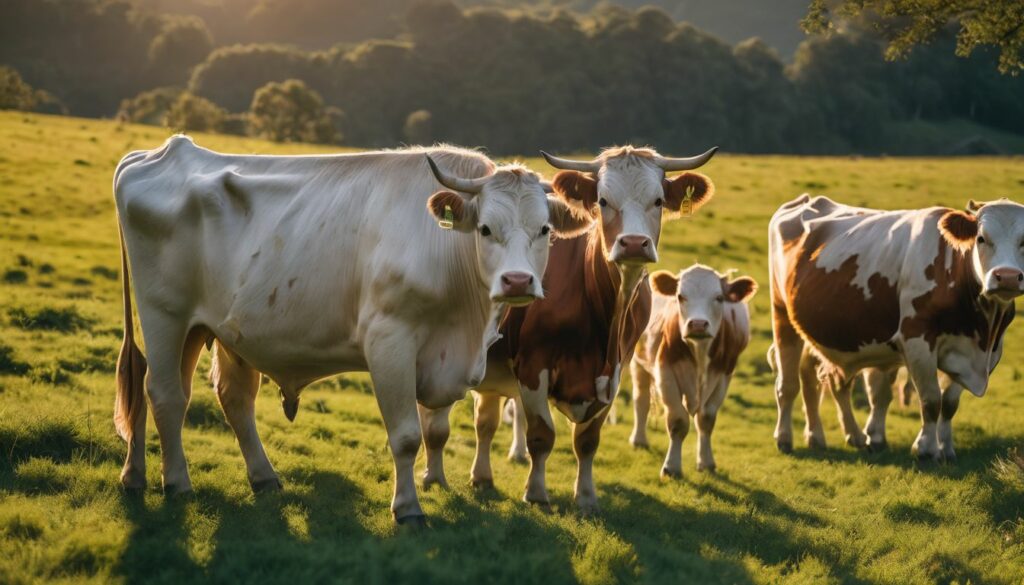Are you looking to maximize the health of your livestock and get the most out of your pastures? If so, understanding the art of pasture management is key. Many farmers and ranchers face challenges with overgrazed fields, malnourished animals, and decreased land productivity.
These issues not only hurt your business but can also take a toll on the environment.
Did you know that with proper grazing techniques, you can dramatically boost forage production? That’s right; experts have found up to a 20% increase in growth when rotationally managed compared to set-stocking.
This article will guide you through effective strategies for responsible pasture use throughout the seasons. You’ll learn how this can lead to healthier animals, improved soil quality, and ultimately, more sustainable farming practices.
Get ready to see green—not just in your pastures but also in your operation’s vitality! Keep reading; answers await.
Key Takeaways
- Proper pasture management helps in maintaining high – quality and productive pastures, providing optimal nutrition for livestock, improving soil health, reducing weed pressure, and promoting sustainable land management.
- Seasonal pasture management is crucial for ensuring continuous supply of nutritious forage throughout the year. Winter grassland management ensures adequate grazing areas during colder months, spring pasture management optimizes growth of new grasses, summer pasture management maintains high-quality grazing areas while allowing recovery and growth of pastures, and fall pasture management prepares the land for winter and ensures adequate forage reserves.
- Implementing managed grazing techniques like rotational grazing and intensive rotational grazing can significantly improve pasture quality by preventing overgrazing, reducing parasite load and disease transmission among livestock, enhancing plant diversity and resilience, minimizing waste through better forage consumption, increasing productivity of pastures, promoting soil health by minimizing compaction and erosion.
Importance of Proper Pasture Management
Proper pasture management ensures high quality and productive pastures, optimal nutrition for livestock, improved soil health, reduced weed pressure, and sustainable land management.
Ensures high quality and productive pastures
Good pasture management makes sure the grass livestock eat is top-notch. This means animals get tasty, healthy food that helps them grow strong and stay healthy. When pastures are cared for the right way, they can give more food for cows, sheep, and goats to munch on.
Pasture care lets plants rest which makes them better and yummier.
If farmers let their fields rest a bit, their plants grow better. The land then can feed more animals over time. Plus doing this well can bump up how much green stuff your field makes by 20%.
Keeping pastures shipshape is also great for the soil and keeps farms working well.
Next up: giving animals the best stuff to eat from these lush meadows leads to them being super happy and healthy!
Provides optimal nutrition for livestock
Proper pasture management ensures that livestock have access to high-quality forage, leading to improved nutrition and overall animal health. By rotating grazing areas, animals can feed on fresh and nutrient-rich grass which helps in maintaining their well-being.
This leads to better weight gain and productivity among the livestock while also reducing the need for supplemental feeding. Additionally, managed grazing systems maintain a balanced diet for the animals, providing essential nutrients crucial for their growth and development.
Implementing proper pasture management practices not only benefits livestock but also contributes significantly to sustainable land management, promoting healthier ecosystems. Effective utilization of rotational grazing maximizes the nutritional value of available forage while improving soil health and preventing erosion.
Investing in holistic farm management techniques further enhances the nutritional resources available to the livestock through optimal pasture conditions.
Improves soil health and prevents erosion
Improving soil health and preventing erosion is crucial for sustainable pasture management. Proper grazing techniques help increase ground cover, which reduces soil erosion. By rotating livestock to different areas, the soil gets a chance to rest and recover, enhancing its overall health.
Additionally, regenerative grazing practices focus on building soil health by managing livestock on various types of forages, further reducing erosion and improving the land’s long-term productivity.
By implementing managed grazing systems as part of pasture management certification, farmers can promote healthier soils while also ensuring optimal nutrition for their livestock. This can lead to increased forage production and extended grazing seasons, benefiting both the environment and the economic sustainability of livestock operations in a holistic manner.
Reduces weed pressure
Improves soil health and prevents erosion by implementing proper pasture management, leads to reduced weed pressure. Effective grazing management strategies such as rotational grazing and intensive rotational grazing can naturally suppress weed growth, promoting the dominance of desirable forage species over unwanted weeds.
This not only helps in maintaining high forage quality but also reduces the need for herbicides, contributing to a more sustainable and environmentally friendly approach to pasture management while maximizing livestock nutrition.
Promotes sustainable land management
Proper pasture management promotes sustainable land management by improving soil health and preventing erosion, essential for maintaining the long-term productivity of grazing areas.
It minimizes soil compaction and enhances water infiltration, leading to better absorption, reduced runoff, and improved nutrient cycling. Sustainable grazing practices also support biodiversity and wildlife habitat while conserving natural resources for future generations.
Effective pasture management emphasizes responsible stewardship of the land, ensuring that livestock can thrive without degrading the ecosystem. This holistic approach supports environmental balance while optimizing livestock production.
Now let’s explore how pasture management impacts different seasons throughout the year.
Benefits of Pasture Management by Season
Winter grassland management ensures that livestock have access to nutritious forage during the colder months, spring pasture management allows for optimal growth of new grasses, summer pasture management provides ample grazing opportunities, and fall pasture management helps prepare pastures for winter grazing.
Winter grassland management
Winter grassland management is crucial for maintaining livestock grazing areas during the colder months. Effective management involves monitoring forage availability and quality to ensure adequate nutrition for animals.
This includes planning for winter cover crops and utilizing grazing techniques that protect soil health and encourage regrowth when conditions improve, ultimately supporting the productivity of livestock.
Turning our attention to “Spring pasture management,” it’s essential to prepare grazing areas for the growing season while optimizing animal welfare and land sustainability.
Spring pasture management
After addressing winter grassland management, transitioning to spring pasture management is crucial for ensuring continuous high-quality forage supply for livestock. Spring pasture management involves adjusting grazing strategies and monitoring the growth of new vegetation as the weather warms up.
It’s essential to balance the nutritional needs of livestock with the regrowth of pastures after winter dormancy. Spring provides an opportunity to assess soil conditions, implement soil testing, and plan for weed control and fertilization measures that will support optimal pasture growth.
Effective spring pasture management can lead to increased production of nutritious forage, providing a vital food source for livestock during this period of rapid vegetative growth.
Summer pasture management
During the summer, pasture management is crucial for maintaining high-quality grazing areas. Proper management ensures that livestock have access to nutritious forage while allowing the pastures to recover and grow.
Effective summer management practices include rotational grazing, which allows specific areas to rest and regrow, thereby ensuring a continuous supply of fresh forage throughout the season.
Additionally, implementing technology such as EOSDA Crop Monitoring can help monitor pasture conditions and adjust grazing patterns accordingly. By focusing on soil testing and fertilization during this time, pH control can be maintained, promoting healthy plant growth and optimal nutrition for livestock.
Fall pasture management
In the fall, pasture management is crucial for preparing the land for winter and ensuring adequate forage reserves. It involves assessing and renovating pastures, planting cover crops to protect soil from erosion over winter, adjusting grazing strategies to allow adequate rest periods, repairing fences as needed, conducting soil tests to determine nutrient levels and applying fertilizers if necessary.
Ensuring proper fall pasture management sets the stage for healthy regrowth in spring and supports livestock with high-quality forage during the winter months.
Fall pasture management also involves monitoring cattle grazing practices to prevent overgrazing while providing sufficient nutrition. This ensures that pastures can recover during colder months and remain productive come spring.
Effective Pasture Management Practices
Utilize rotational grazing and soil testing to improve pasture quality. Interested in learning more about effective management practices? Keep reading!
Rotational grazing
Rotational grazing is a method of grazing where livestock are moved between multiple pastures or paddocks. This type of grazing involves dividing the pasture into smaller areas and rotating the livestock through these sections on a regular basis.
- Helps to prevent overgrazing in specific areas, allowing forage to recover and ensuring consistent availability of nutritious grass for livestock.
- By moving animals to fresh paddocks regularly, rotational grazing can reduce the parasite load and minimize the risk of disease transmission among livestock.
- Allows for better utilization of forage as it encourages even grazing across the entire pasture, leading to improved pasture health and productivity.
- Rotational grazing promotes soil health by minimizing soil compaction and erosion, thus preserving the long-term viability of pastures.
- Enhances plant diversity and resilience, contributing to overall ecosystem health while maintaining high-quality forage options throughout grazing seasons.
Intensive rotational grazing
After implementing rotational grazing, intensive rotational grazing takes management to the next level with increased frequency of moving livestock, creating several benefits:
- Improved forage utilization: Livestock are moved more frequently to fresh pastures, allowing for better forage consumption and minimizing waste.
- Increased pasture productivity: The frequent movement of livestock stimulates plant growth and prevents overgrazing, leading to healthier and more productive pastures.
- Enhanced soil health: Intensive rotational grazing encourages deeper root systems and improved soil structure, promoting water infiltration and reducing erosion.
- Nutrient distribution: By evenly distributing manure across pastures, intensive rotational grazing enhances soil fertility and nutrient cycling.
- Weed suppression: Regular movement of livestock can help control weed populations by trampling and consuming undesirable plants.
Use of technology (EOSDA Crop Monitoring, satellite remote sensing)
Utilizing technology like EOSDA Crop Monitoring and satellite remote sensing enhances pasture management by providing real-time data on pasture conditions, vegetation health, and soil moisture levels.
This enables livestock producers to make informed decisions and optimize grazing strategies for maximum forage production while preserving the land’s sustainability. With accurate monitoring through these technologies, fencing projects can be strategically planned, soil pH can be controlled effectively, and fence maintenance can be targeted, ultimately improving overall pasture quality and grazing efficiency.
These advanced technological tools also aid in identifying areas for pasture improvement, implementing effective weed control measures, and enhancing grazing management practices. By integrating EOSDA Crop Monitoring and satellite remote sensing into pasture management strategies, livestock producers can achieve greater productivity while minimizing environmental impact through efficient resource utilization.
Soil testing and fertilization
To ensure proper pasture management, soil testing and fertilization play a crucial role in maintaining nutrient balance and promoting healthy forage growth.
- Soil testing involves taking samples from different areas of the pasture to analyze the pH levels, nutrient content, and any deficiencies that may affect plant growth.
- The results of soil testing guide the selection of appropriate fertilizers and amendments to address any deficiencies, ensuring that the pasture maintains its productivity.
- Fertilization replenishes essential nutrients such as nitrogen, phosphorus, and potassium, which are vital for supporting healthy forage growth and overall pasture health.
- Proper fertilization promotes vigorous root development and helps plants withstand environmental stresses such as drought or grazing pressure.
- Effective soil testing and fertilization practices contribute to improved forage quality, leading to better nutrition for grazing livestock and increased overall productivity of the pasture.
Weed control and forage management
Weed control and forage management are vital aspects of proper pasture management for livestock grazing. It influences the quality and quantity of forage available to the animals, impacting their nutrition.
- Implement Integrated Weed Management (IWM) strategies:
- Utilize selective herbicides:
- Practice regular mowing:
- Maintain proper stocking rates:
- Consider reseeding bare spots:
Conclusion: Benefits of Proper Pasture Management for Livestock Grazing
In conclusion, good pasture management benefits both the land and the animals. Implementing simple strategies can lead to noticeable improvements in forage production and soil health.
Have you considered trying rotational grazing on your farm? By practicing effective pasture management, you can contribute to sustainable land use and ensure better nutrition for your livestock.
The impact of proper pasture management goes beyond just the farm – it’s crucial for environmental conservation too. Take small steps towards better pasture management today; the results will speak for themselves!
FAQs
1. What is pasture management for livestock grazing?
Pasture management for livestock grazing means taking care of the land where animals eat so that the soil and grass stay healthy.
2. Why is it important to control soil pH in pastures?
Controlling soil pH in pastures helps make sure the ground has just the right balance for plants to grow well, which gives good food for the animals.
3. How can proper pasture management help animals?
When you manage pastures well, your animals can get more and better grass to eat, which helps them stay healthy and grow.
4. Can managing pastures help with other parts of livestock management too?
Yes! Good pasture care also makes it easier to look after your animals because they have a nice place to live and plenty of food from the land.





